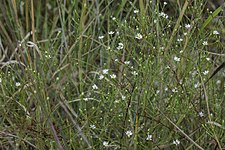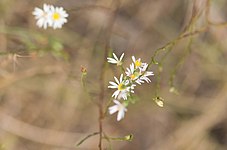| Symphyotrichum depauperatum | |
|---|---|

| |
| S. depauperatum from the serpentine grassland demonstration area in Nottingham, Pennsylvania. | |
| Conservation status | |
 Imperiled (NatureServe) | |
| Scientific classification | |
| Kingdom: | Plantae |
| Clade: | Tracheophytes |
| Clade: | Angiosperms |
| Clade: | Eudicots |
| Clade: | Asterids |
| Order: | Asterales |
| Family: | Asteraceae |
| Genus: | Symphyotrichum |
| Section: | Symphyotrichum sect. Symphyotrichum |
| Species: | S. depauperatum |
| Binomial name | |
| Symphyotrichum depauperatum (Fernald) G.L.Nesom | |

| |
| Endemic distribution | |
| Synonyms | |
|
Basionym
| |
Symphyotrichum depauperatum (formerly Aster depauperatus), commonly known as serpentine aster or starved aster, is a rare species in the family Asteraceae adapted to serpentine barrens, an ecosystem with a high concentration of toxic metals in the soil. It has been found in Pennsylvania, Maryland, and on some diabase glades in North Carolina. It grows to 50 centimeters (1+3⁄4 feet) and has white ray florets surrounding a center of yellow disk florets.
Description
Symphyotrichum depauperatum is a perennial, herbaceous plant that may reach up to 50 centimeters (1+3⁄4 feet) tall, with 1–3 stems. The leaves are narrow and generally 2–4 centimeters (3⁄4–1+1⁄2 inches) long. The plant produces numerous flower heads in branched arrays, each head with 7–14 white or, rarely, pink ray florets surrounding 7–17 yellow disk florets.
Taxonomy
Within the genus Symphyotrichum, S. depauperatum has been classified in subgenus Symphyotrichum section Symphyotrichum subsection Porteriani. Its full name with author citation is Symphyotrichum depauperatum (Fernald) G.L.Nesom. It was first described by American botanist Merritt Lyndon Fernald in 1908 as Aster depauperatus.
Distribution and habitat

S. depauperatum is adapted to serpentine barrens, an ecosystem with a high concentration of toxic metals in the soil. It has been found in Baltimore and Cecil Counties, Maryland; Granville County, North Carolina; and, Chester, Delaware, and Lancaster Counties, Pennsylvania.
Serpentine aster has been called a "flagship species" of the unique serpentine ecosystem and was once thought to be endemic to these barrens, but it also has been found to occur in a disjoint population on diabase glades in Granville County, North Carolina.
Conservation
Symphyotrichum depauperatum is classified by the state of Pennsylvania as a threatened species because its range is restricted to a few limited areas, and the majority of its populations occur on sites threatened by quarrying, housing development, and industrial development.
As of August 2022, NatureServe listed it as Globally Imperiled (G2); Critically Imperiled (S1) in Maryland and North Carolina; and, Imperiled (S2) in Pennsylvania. NatureServe's most recent review of S. depauperatum's global status was 3 October 1997.
Citations
- ^ NatureServe (2022).
- ^ Gustafson & Latham (2005), p. 1447.
- ^ POWO (2021).
- ^ Brouillet et al. (2006).
- USDA, NRCS (2014).
- Nesom (1994), p. 270.
- IPNI (2021).
- Gustafson & Latham (2005), p. 1445.
- Gustafson & Latham (2005), pp. 1449–1450.
- Pennsylvania DCNR (n.d.).
References
- Brouillet, L.; Semple, J.C.; Allen, G.A.; Chambers, K.L.; Sundberg, S.D. (2006). "Symphyotrichum depauperatum". In Flora of North America Editorial Committee (ed.). Flora of North America North of Mexico (FNA). Vol. 20. New York and Oxford: Oxford University Press. Retrieved 3 July 2021 – via eFloras.org, Missouri Botanical Garden, St. Louis, MO & Harvard University Herbaria, Cambridge, MA.
- Gustafson, D.J.; Latham, R.E. (June 2005). "Is the serpentine aster, Symphyotrichum depauperatum (Fern.) Nesom, a valid species and actually endemic to eastern serpentine barrens?". Biodiversity and Conservation. 14 (6): 1445–1452. Bibcode:2005BiCon..14.1445G. doi:10.1007/s10531-004-9670-x. Archived (PDF) from the original on 6 September 2021. Retrieved 5 September 2021 – via ResearchGate (free).
- IPNI (2021). "Aster depauperatus Fernald, Rhodora 10: 94 (1908)". International Plant Names Index (IPNI). Royal Botanic Gardens, Kew; Harvard University Herbaria & Libraries; Australian National Botanic Gardens. Retrieved 16 January 2022.
- NatureServe (5 August 2022). "Symphyotrichum depauperatum Serpentine Aster". explorer.natureserve.org. Arlington, Virginia. Retrieved 12 August 2022.
- Nesom, G.L. (September 1994). "Review of the taxonomy of Aster sensu lato (Asteraceae: Astereae), emphasizing the New World species". Phytologia. 77 (3) (published 31 January 1995): 141–297. ISSN 0031-9430. Retrieved 23 August 2021 – via Biodiversity Heritage Library.
- Pennsylvania DCNR (n.d.). "Serpentine Aster Profile". Pennsylvania Department of Conservation, Natural Resources Wildlife Resource Conservation Fund. Archived from the original on 10 June 2011. Retrieved 19 September 2009.
- POWO (2021). "Symphyotrichum depauperatum (Fernald) G.L.Nesom". Plants of the World Online. Royal Botanic Gardens, Kew. Retrieved 15 December 2021.
- USDA, NRCS (2014). "Symphyotrichum depauperatum". PLANTS Database. United States Department of Agriculture (USDA). Retrieved 3 July 2021.
External links
Information about Symphyotrichum depauperatum also can be seen at the following pages:
- Ladybird Johnson Wildflower Center (wildflower.org)
- University of Waterloo Astereae Lab
- Vascular Plants of North Carolina
- Pennsylvania Natural Heritage Program
- Maryland Biodiversity Project
- Symphyotrichum depauperatum as Pennsylvania Threatened in the Pennsylvania Code
| Taxon identifiers | |
|---|---|
| Symphyotrichum depauperatum |
|
| Aster depauperatus | |


